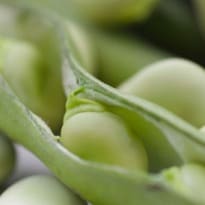Broad beans are a beautiful looking, highly companionable veg stuffed with protein.
With their verdant sheen and kidney-shaped curves, few vegetables rival broad beans in the looks department. True, a little effort in the form of double podding is needed to show them off. First you liberate the beans from their outer jackets (a doddle). Next, you immerse the beans in boiling water for two minutes, refresh them in cold, and drain them. Then by squeezing them gently, you can slip the seductive green beans out of their grey, papery skins.
Broad beans are most definitely not fast food, but when you bite through their silky exterior into their sweetly leguminous floury centre, you'll remember why they are worth the bother. They're best when they are relatively small and new; they become duller tasting and more like dried pulses with age. Mint, crispy bacon and pecorino all make perfect companions.
Why are broad beans good for me?
Broad beans are an excellent vegetable source of protein and fibre. This may be a winning combination for weight loss. A study published in the European Journal of Clinical Nutrition in 2010 found that overweight women on a high-protein, high-fibre diet lost more weight than those on the standard high-carbohydrate, low-fat regime that currently forms the basis of government "healthy eating" advice. Broad beans are also rich in both folate and B vitamins, which we need for nerve and blood cell development, cognitive function and energy.
Where to buy and what to pay
Reasonably disease-resistant and easy to cultivate, broad beans are one of the more reliable seasonal highlights of late spring/early summer. You'll find them particularly nice and fresh at farmers' markets or in organic vegetable boxes. Guide price: £6/kg.
Joanna Blythman is the author of What To Eat (Fourth Estate, £9.99). To order a copy for £7.99 with free UK p&p, go to guardianbookshop.co.uk
Broad beans with pearl barley and feta
At the beginning of the season, when the broad beans are small and tender, I tend not to pop them out of their skins in this recipe, but with the bigger, slightly tougher ones it's really worth the slightly painstaking effort. If you are using skinned broad beans, just add them at the end to heat through.
Serves 4
1 tbsp olive oil
30g butter
1 bunch spring onions, trimmed and sliced into 1cm pieces
2 garlic cloves, peeled and crushed
400g pearl barley, washed thoroughly and left to soak for 20 minutes
800g broad beans, podded and, if large, blanched and popped out of their skins
200ml white wine
1 litre vegetable stock
A couple of sprigs of mint, chopped
A small handful of parsley, chopped
100g feta, crumbled
1 Heat the oil and half the butter in a large, heavy-based pan and add the spring onions and garlic. Cook gently until soft, about 5 minutes, then stir in the pearl barley.
2 Cook for a minute or so, then add the broad beans and, soon after, the white wine. Cook until it has been absorbed then add the stock.
3 Simmer, stirring often, until the barley is tender. This will take about 30 minutes; top up with hot water if the stock is absorbed before the barley turns soft.
4 Take off the heat and stir in the rest of the butter, then season to taste, bearing in mind you will be finishing the dish with some salty cheese.
5 Leave to sit, covered, for 5 minutes then stir in the herbs and feta. Serve.
Rosie Sykes is head chef of Fitzbillies and co-author of The Kitchen Revolution (Ebury Press, £27.50). To order a copy for £19.99 with free UK p&p, go to guardianbookshop.co.uk
In Picture: Broad beans - an excellent source of protein and fibre. Photograph: Alamy






